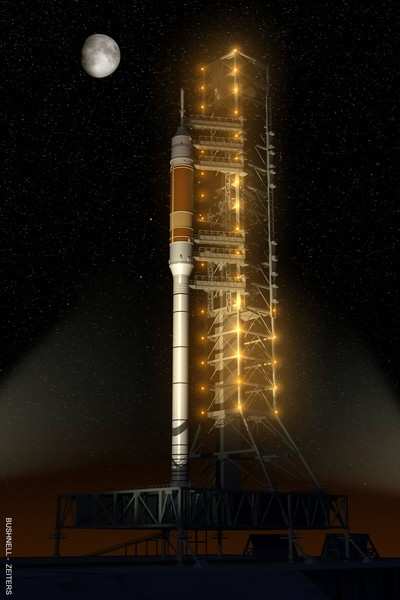Officials Say Agency May Be Able To Speed Up Program
Hoping to divert the public's attention from scathing media
reports, suggesting the Ares I rocket is a multi-billion
boondoggle... on Wednesday officials at NASA reiterated their
confidence in the design of the next-generation launch vehicle, and
also suggested NASA could fly Ares sooner than the current target
date of 2015.

Jeff Hanley, manager of the Constellation manned space program,
said NASA continues to work on a plan that would result in the
first manned Ares launch within six years. "We're shooting for a
more aggressive date of September 2014," Hanley said in a
conference call, reports The Associated Press. "The real stretch is
what can we do to accelerate as much as 18 months. That will be
particularly hard."
Hanley added a study is now underway to determine whether such
an ambitious launch date is feasible. It should be completed in
December; the first unmanned Ares I-X test flight is scheduled
for the middle of next year, barring delays in NASA's plans to
launch a shuttle repair mission to the Hubble Space Telescope.
NASA officials then criticized recent media reports suggesting
Ares may be hopelessly, and dangerously, flawed.
As ANN reported, an investigative report
published by The Orlando Sentinel earlier this week suggested an
inherent problem with the rocket's design could lead to a condition
known as "liftoff drift," which in the worst-case scenario might
cause the rocket to impact the launch tower on liftoff.
That's bunk, said Ares program manager Steve Cook.
 "First of all, launch vehicles experience lift-off drift
primarily due to winds at the launch pad and it's a manageable
phenomenon," he said. "In the very heavy wind conditions that we
are designed to -- 34 knots, which is significantly higher than
what shuttle uses today -- Ares 1 can use its built-in thrust
vector controls to steer away from the pad tower."
"First of all, launch vehicles experience lift-off drift
primarily due to winds at the launch pad and it's a manageable
phenomenon," he said. "In the very heavy wind conditions that we
are designed to -- 34 knots, which is significantly higher than
what shuttle uses today -- Ares 1 can use its built-in thrust
vector controls to steer away from the pad tower."
Cook -- who, like other NASA officials on the conference call,
declined to identify the Sentinel by name -- added another solution
to the problem is to simply launch Ares in more favorable wind
conditions, negating the risk of drift. The space shuttle is
launch-limited to winds less than 19 knots.
"The wind condition that we are concerned about is a southerly
wind at 34 knots. In our estimate that would only happen about 0.3
percent of the time in any case," Cook said. "So this is another
issue that's been taken very much out of context."
Pointedly noting that "everybody's entitled to an opinion," Cook
said Ares naysayers are barking up the wrong tree in suggesting
NASA should find another option... especially when everyone
involved is concerned about the five-year gap between the September
2010 retirement date for the space shuttle, to the first manned
Ares launch.
"I think you've got to stick to the facts of engineering and
project management, and the fact that we're three years into this.
You'd basically back yourself up three years and start over again,
so just watch the gap grow."
 ANN's Daily Aero-Linx (05.02.24)
ANN's Daily Aero-Linx (05.02.24) ANN's Daily Aero-Term (05.02.24): Touchdown Zone Lighting
ANN's Daily Aero-Term (05.02.24): Touchdown Zone Lighting Aero-News: Quote of the Day (05.02.24)
Aero-News: Quote of the Day (05.02.24) ANN FAQ: Contributing To Aero-TV
ANN FAQ: Contributing To Aero-TV NTSB Final Report: Cirrus Design Corp SR20
NTSB Final Report: Cirrus Design Corp SR20




